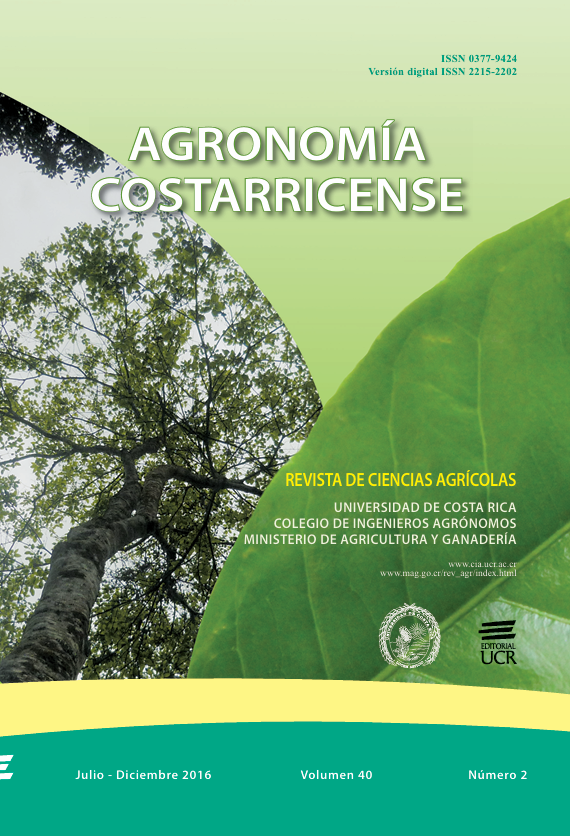Abstract
Sustainable agricultural practices to increase the yields of different crops, in Sancti Spiritus, Cuba. The present research took place in 4 agro-ecosystems of the Sancti Spiritus province, Cuba. The productive response of different crops of vegetables and grains to coverage residues on the ground, and to the use of biofertilizers under field experimental conditions and in different types of soil were studied. Among the vegetables, onion (Allium cepa L.) and tomato (Solanum lycopersicum L.) were evaluated; for both, different types of dead coverage on the floor were used. In the of grains, Fitomas- E and Biobras 16 were used on the bean crop (Phaseolus vulgaris L.) and efficient microorganisms in corn (Zea mays L.). The experimental design for the 4 experiments was of random blocks. In all experiments the crop yield was higher in treated variants, as compared to the control treatment. When dead coverage was used in onion and tomato, the highest yield was obtained with the remains of rice harvest: 14.08 and 31.25 t.ha-1 respectively. In the bean crop, the best combination was the joint implementation of Fitomas E and Biobrás 16, with a yield of 2.23 t.ha-1. Corn production was higher by more than 50% when efficient microorganisms were used in correspondence with the control variant. The agricultural practices evaluated contributed to improve the productive response in all crops where they were applied.References
Alarcón, A; Barreiro, P; Alarcón, A; Díaz, SY. 2012. Efecto del Biobras 16 y el Fitomas E en algunos indicadores del crecimiento y el rendimiento del tomate (Solanum lycopersicum L.) variedad “Vyta”. Revista Granma Ciencia 16(1):1-10.
Camelo, M; Vera, SP; Bonilla, R. 2011. ‘‘Mecanismos de acción de las rizobacterias promotoras del crecimiento vegetal’’. Revista CORPOICA. Ciencia y Tecnología Agropecuaria 12(2):159-166.
Fonseca, R; Molinet, D; Arias, F; Agüero, Y; Torres, M. 2013. Efecto de los hongos micorrizógenos arbusculares (cepa Glomus fasiculacum) y la materia orgánica en plántulas de tomate (Solanum lycopersicum L.). Revista Granma Ciencia 17(2):12-22.
Fuentes, P; Peña, K; Cristo, M. 2008. Sistema de siembra con cobertura en el cultivo de la cebolla (Allium cepa L.), 1: Efecto sobre los rendimientos. Cuadernos de Fitopatología. Revista de Fitopatología y Entomología 84(2):10-13.
Guevara, TE; Méndez, GJC; Vega, LJ; González, POS; Puertas, AA; Fonseca, CJ. 2013. Influencia de diferentes dosis de FitoMas-E en el frijol común. Centro Agrícola 40(1):39-44.
Hernández, A; Pérez, JM; Bosch, D; Castro, N. 2015. Clasificación de los suelos de Cuba. Ediciones INCA. Mayabeque, Cuba. 93 p.
Hernández, AM; Morales, MO; Ascanio, Y; Borges, D; Vargas, YA. 2013. Degradación de los suelos Ferralíticos Rojos Lixiviados y sus indicadores, de “La llanura roja de la Habana”. Cultivos Tropicales 34(3):45-51.
Higa, T; Parr, JF. 1994. Beneficial and effective microorganisms for a sustainable agriculture and environment Vol. 1, 16 p. Atami, Japan: International Nature Farming Research Center.
LABIOFAM. 2014. Vademecum. La Habana, Cuba: Palcograf. 303 p.
López, M. 2009. Contribución al manejo de prácticas orgánicas y sostenibles a través del uso de coberturas muertas en el cultivo del ajo (Allium sativum L.). En Memorias Seminario Científico del Instituto Nacional de Ciencias Agrícolas (INCA) (p. 16-18).
La Habana, Cuba: Instituto Nacional de Ciencias Agrícolas (INCA). Martínez, R; Dibut, B. 2012. Biofertilizantes bacterianos. La Habana, Cuba, Editorial científica técnica. 279 p.
Martínez, R; Grillo, E; Orellana, R. 2011. Uso de materiales locales como arrope para contribuir a la eficiencia de los sistemas productivos. Agricultura Orgánica 17(1):35-36.
MINAG (Ministerio de la Agricultura, Cuba). 2010. Ministerio de la Agricultura, Instituto de Investigaciones de Granos, Instituto de Investigaciones del Tabaco. Guía Técnica del Cultivo del Frijol Común. 12 p.
Olivera, D; Ayala, J; Calero, A; Santana, M; Hernández, A. 2014. Prácticas agroecológicas en la provincia de Sancti Spíritus. Microorganismos eficientes (EM) una tecnología apropiada sobre bases agroecológicas. In Neder, RT; Murilo, F. (eds.), Ciência, tecnologia, sociedade (cts) na construção da agroecología. Brasilia, Brasil, Observatório do Movimento pela Tecnologia Social na América Latina / NEPEAS. p. 77-83.
ONE (Oficina Nacional de Estadística, Cuba). 2014. Agricultura, ganadería, silvicultura y pesca. Producción agrícola por cultivos seleccionados. Ed. 2015, Cienfuegos, Cuba. 33 p.
Peña, K; Rodríguez, JC; Meléndrez, JF. 2015. Beneficios de la cobertura muerta para el cultivo del tomate (Solanum lycopersicum L.) en Sancti Spíritus, Cuba. Infociencia 19(2):1-12.
Peña, K; Rodríguez, JC; Meléndrez, JF. 2016. “El VIUSID agro una alternativa en el incremento de la producción de tomate (Solanum lycopersicum L.)” (en línea). Revista Caribeña de Ciencias Sociales. 6 p. Consultado junio 2016. Disponible en http://www. eumed.net/rev/caribe/2016/05/viusid.html
Peña, K; Rodríguez, JC; Olivera, D. 2013. Coberturas muertas y regulación de arvenses en el cultivo del tomate (Solanum lycopersicum L.). Agricultura Orgánica 19(4):32-35.
Pulido, J; Soto, R; Castellanos, L. 2013. Efecto del Biobras 16 y el Fitomas E en el tomate de crecimiento indeterminado en casas de cultivo protegido. Centro Agrícola 40(1):29-34.
Robaina, N; Socarrás, A; Pérez, D. 2010. Importancia de la cobertura vegetal para el mejoramiento de la diversidad biológica del suelo. Agricultura Orgánica 16(2):30-31.
SPSS (Statistical Package for the Social Sciences, USA). 2006. Statistical Package for the Social Sciences (SPSS), version 15.0.1. Chicago, USA: SPSS Inc. Programa estadístico.
Terry, E; Leyva, A; Hernández, A. 2005. Microorganismos benéficos como biofertilizantes eficientes para el cultivo del tomate (Solanum lycopersicum L.). Revista Colombiana Biotecnología 7(2):47-54.
WRB (World reference base for soil resources, Italia). 2014. International soil classification system for naming soils and creating legends for soil maps. World Soil Resources Reports Nº. 106. FAO, Rome, Italia.


